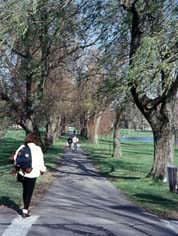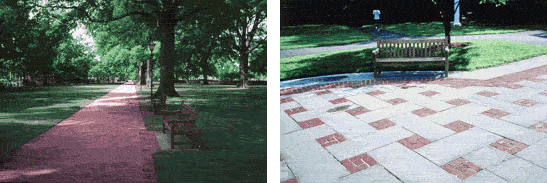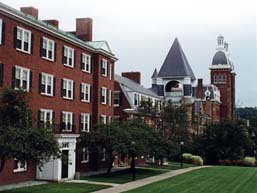Design Details: A Devilish Theme I could retire today if I had a dollar for every time I heard someone say, | ||||||
To hell with the devil, it is in the details that campus and building designs are elevated from the quotidian to the exceptional. Broad campus design and large-scale campus planning elements succeed or fail by how we experience and perceive them. It is the small, human-scale details that help us understand and appreciate our environment. It is difficult to discern the scale of a blank wall — but make that wall out of bricks, and our familiarity with the size of a brick gives scale to the wall. |
|
|||||
Campus Walks: Links, Transitions, Learning Environments |
|||||||
 |
The campus experience for students — whether traditional residential or non-traditional or commuter — is an immersion in learning, a period of transformation. Meaningful campuses will support and extend the learning experience.
Consider the campus walkway as one place for learning. Factor that a typical student taking a 15-credit load may attend class as many times each week. If there is a 5 to 10 minute walk to or between course sessions, that means spending anywhere from an hour to five hours walking to and from class each week. Walkways not only provide the link and transition among places on campus (parking lot, dormitory, classroom, laboratory, library, campus center, and recreational facilities, etc.), they can also be places for learning, if sensitively designed. |
||||||
| width | Campus walks need to be broad to be useful. A width of at least 10 feet will support and encourage people to walk together and talk — to socialize and strengthen life-long links to the institution and to their peers, and even to discuss their studies and ideas. Wide walkways also allow the intermittent passage of maintenance and emergency vehicles and prevent truck tires from creating ruts in the sod at walkway edges. |
||||||
| light | Campus walks need to be well lit for nighttime security and well maintained for safety. |
||||||
details |
Walkways need to be designed for water to drain away without puddling (icing). A slightly crowned profile (high center, low edges) is recommended. Paving materials can be simple and inexpensive (e.g., macadam) and, even so, can be enhanced with attractive detailing. A simple edging (such as brick, granite cobbles, or cut stone) can create a handsome effect without using an extensive amount of expensive material. |
||||||
| details | Changes in paving patterns at transition areas will alert pedestrians to key features: major walkway intersections, building entries, street crossings, driveways, etc. |
||||||
| details | Walks that cross streets and roads at a uniform level will not require pedestrians or wheel chairs to negotiate curbs. Making motor vehicles change elevation will emphasize the pedestrian-oriented aspect of a campus. Without curbs at crossings, however, the addition of reasonably spaced bollards (low posts) at the walk-crossing transition will serve to separate vehicles from the pedestrian realm. |
||||||
| and more... | Providing benches along walkways is not only considerate design but also a logical extension of walkways as learning environments. Learning may be fostered in surrounding landscapes as well. A variety of plantings may serve to demonstrate plant selections reflecting climate and region. Labeling of specimens, whether trees or herbaceous plants, further extends scientific knowledge. |
||||||
 |
|||||||
|
|||||||
News New Board Member Campus Plans Project Kaleidoscope Presentation |
Coherent Landscape Design Institutional image and an institution's campus are inextricably linked, whether one looks through Kevin Lynch's academic, analytical lens, or through the market-focused lens of the latest branding study. What are the primary components of institutional image? The most vigorously pursued element is probably "reputation," typically rooted in the quality and distinctiveness of program offerings and the contribution made to intellectual and societal advancement. The most diligently cultivated physical attribute is unquestionably an institution's collection of buildings. These buildings can simultaneously support programmatic achievements and endow them with a memorable physical expression. One of the least emphasized physical elements is the campus landscape. The landscape provides the setting for buildings and the connections between them and to the community beyond the campus boundaries. Too often, the landscape lacks effective advocates and, therefore, funding. This makes creation and maintenance of the landscape an ad hoc, disjointed process. Landscaping then becomes building-related in its creation and maintenance is meager at best. Hence, a major asset and contributor to campus image is under-employed. A thoughtful planning and design approach integrates architecture with landscape can help give greater presence to a campus with an unremarkable or highly varied character. Appreciating and coordinating landscape elements campus-wide — trees, shrubs, flowers, grass, benches, memorials, sculptures, plazas, paths, drives, and parking areas — can make a significant improvement in campus livability and image. Providing adequate funding and staff for continuous maintenance, renewal, and enhancement can knit the campus together with a rich, vibrant, useable, and handsome landscape setting. George Mathey |
||||||
Related Topics &
|
|||||||
© Copyright 2004 |
|||||||





